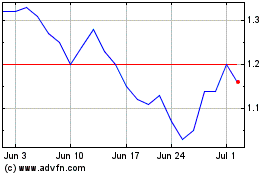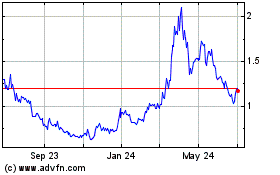Atossa Therapeutics, Inc. (Nasdaq: ATOS), a clinical stage
biopharmaceutical company developing innovative proprietary
medicines to address significant unmet need in cancer, today
announces the issuance of the following Letter to Shareholders from
Steven C. Quay, M.D., Ph.D., the Company’s CEO and Chairman:
TO OUR VALUED STOCKHOLDERS:
2022 was a year of significant progress for Atossa. We focused
our development efforts on advancing our breast cancer program with
our patented (Z)-endoxifen, the highest potency Selective Estrogen
Receptor Modifier (SERM). We currently have Phase 2 studies ongoing
in the prevention and treatment settings, both focused on areas of
unmet medical need. Our goal is to both help reduce the incidence
of breast cancer and change the treatment paradigm for patients who
are not benefiting from currently approved drugs.
In October 2022, the U.S. Food and Drug Administration (FDA)
authorized the initiation of our EVANGELINE study, a Phase 2 trial
of (Z)-endoxifen and Exemestane + Goserelin as neoadjuvant
treatment in premenopausal women with ER+/HER2- breast cancer.
While there are several FDA-approved neoadjuvant therapies for ER-
breast cancers, few exist for the ER+ patients, which account for
approximately 78% of breast cancers. We expect to enroll
approximately 175 patients at up to 25 sites across the United
States.
The EVANGELINE study marks the first time our proprietary
(Z)-endoxifen is being investigated in the United States and builds
on the Phase 2 “window of opportunity” study we conducted in
Australia. In that study we showed treatment with (Z)-endoxifen
reduced Ki-67, a commonly used measure of cellular proliferation
and growth in breast cancer tissue, from an average of 25.6% at
screening to 6% on the day of surgery, a 65.1% reduction. This is
clinically meaningful because numerous studies by other groups have
shown a reduction in Ki-67 below 25% improves long term survival
for ER+ breast cancer patients.
The EVANGELINE study will help us better understand what happens
to tumors when patients are treated with (Z)-endoxifen. For
example, is there a pathological response or tumor shrinkage? Even
a partial response in the neoadjuvant setting could change the
primary treatment approach and potentially save patients from
undergoing a radical mastectomy or systemic therapies including
chemotherapy, hormonal therapy, and/or targeted therapy.
We are also testing the hypothesis that treatment with
(Z)-endoxifen could provide clinical benefit without the need for
ovarian suppression. Current treatment approaches for premenopausal
women diagnosed with ER+ breast cancer include using drug therapy
or surgery to prevent the ovaries from making estrogen. ER+ tumors
need estrogen to grow, so lowering hormone levels can restrict
growth. However, patients also experience menopausal symptoms, and
in some cases, treatment induces natural menopause, which can
dramatically impact a patient’s quality of life. There is a
critical need for new treatment approaches that provide clinical
benefit without ovarian suppression.
We also continue to enroll patients in our Phase 2 study
investigating (Z)-endoxifen in premenopausal women with elevated
mammographic breast density (MBD). We announced last fall that the
study was approximately 40% enrolled which, assuming enrollment
continues at the current pace, means we should enroll all 240 study
participants by the end of this year.
MBD is an emerging public health issue affecting more than 10
million women in the United States and many millions more
worldwide. It’s well understood that increased MBD reduces the
ability of mammograms to detect cancer, but studies have also shown
that women with MBD have an increased risk of developing breast
cancer and that the higher the MBD, the higher the incidence of
breast cancer. Importantly, we also know that reducing MBD can lead
to a reduction in the incidence of breast cancer.
Our MBD study, known as the Karisma-Endoxifen study, is a
randomized, double-blind, placebo-controlled trial of healthy,
pre-menopausal women with increased breast density. The treatment
cohort receives daily doses of (Z)-endoxifen for six months, over
the course of which mammograms will be conducted to measure
reduction in MBD. Patients will also be given a mammogram at 24
months to assess the durability of the MBD changes. We believe
(Z)-endoxifen may provide an option for women to proactively reduce
the density of their breasts, which could improve mammography
accuracy and patient care by unmasking cancerous tumors that are
otherwise hidden by breast density.
Given the importance of (Z)-endoxifen to the future of Atossa,
and the significant impact it could have on the prevention and
treatment of breast cancer, it’s critical that we protect the
intellectual property covering our proprietary formulation of the
drug. Our position was further strengthened in March of last year
when the U.S. Patent and Trademark office issued U.S. Patent No.
11,261,151 (the ‘151 Patent). Titled “Methods for Making and Using
Endoxifen,” the ‘151 Patent is directed to compositions of
storage-stable (Z)-endoxifen and methods of treating
hormone-dependent breast disorders using the storage-stable
(Z)-endoxifen. The ‘151 Patent is estimated to expire in 2038.
Another important development in 2022 was our investment in
Dynamic Cell Therapies, Inc. (DCT), a privately held, venture
capital backed developer of CAR-T therapies. DCT is in the
pre-clinical phase of developing controllable CAR-T cells to
address difficult-to-treat cancers. Its platform technology of
dynamic control of engineered T-cells is designed to improve the
safety, efficacy, and durability of CAR-T cell therapies. While
their initial focus is hematologic malignancies, their innovative
approach could also have broad applicability in solid tumors and
autoimmune diseases. Our investment, which totaled $4.7 million and
resulted in Atossa owning approximately 19% of the outstanding
capital stock of DCT, closed in December 2022.
Last year we also made the decision to discontinue our COVID-19
programs due to the rapidly shifting treatment landscape and the
introduction of effective vaccines, which greatly reduced
hospitalizations. Aligned with our sharpened focus on oncology, we
expect to revisit the development of AT-H201 as an inhalation
therapy for cancer patients with compromised lung-function
resulting from radiation treatment in the future. This indication
may fill a compelling unmet medical need because radiation-induced
lung injury, which can limit the overall success of lung cancer
treatment, is often irreversible and poorly treated with current
therapies.
As we look forward to 2023, we are well positioned to continue
accelerating the development of (Z)-endoxifen. Both of our Phase 2
trials are ongoing, and we will provide enrollment and other
updates as developments warrant throughout the year. We also have a
strong balance sheet with no debt and cash, cash equivalents and
restricted cash of approximately $117 million as of September 30,
2022.
On behalf of the board of directors, management, and employees
of Atossa Therapeutics, we thank you for your investment and
continued support of our Company.
Sincerely,
Steven C. Quay, M.D., Ph.D.Chairman of the Board of Directors
and Chief Executive Officer
About Atossa TherapeuticsAtossa Therapeutics,
Inc. is a clinical-stage biopharmaceutical company seeking to
develop innovative medicines in areas of significant unmet medical
need in oncology with a current focus on breast cancer and lung
injury caused by cancer treatments.For more information, please
visit www.atossatherapeutics.com
Contact:Atossa Therapeutics, Inc.Kyle Guse, General Counsel and
Chief Financial Officerkyle.guse@atossainc.com
Atossa Therapeutics (NASDAQ:ATOS)
Historical Stock Chart
From Mar 2024 to Apr 2024

Atossa Therapeutics (NASDAQ:ATOS)
Historical Stock Chart
From Apr 2023 to Apr 2024
